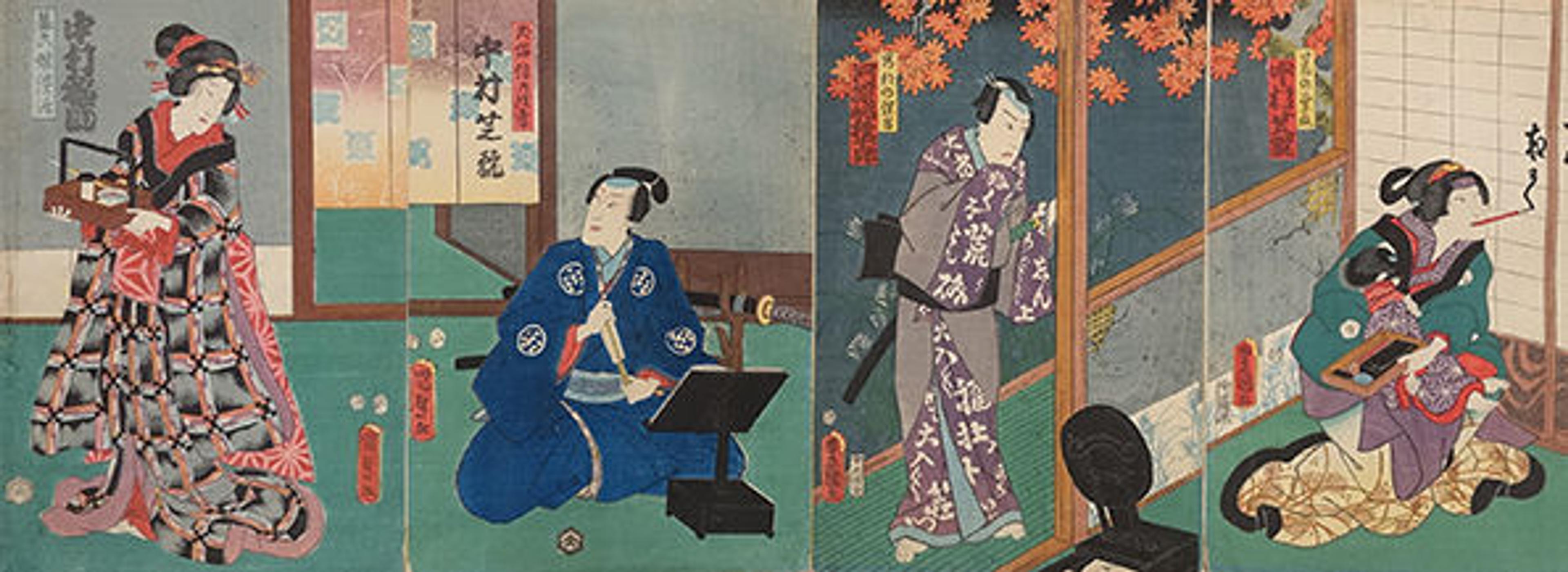Japanese Theater and Textiles

Detail from 東にしきえ (Azuma nishiki-e), 1860s. Watson Library Special Collections
«In conjunction with the symposium The Art of Japanese Books: Uses, Materials, and Block-Printing Techniques, recently hosted by Watson Library's Book Conservation Department, the library is currently displaying three colorful titles on Japanese theater and textile design.»

東にしきえ (Azuma nishiki-e), 1860s. Watson Library Special Collections
From the late Edo period, the striking album of full-color woodblock "actor prints" (yakusha-e) depicts luminaries from kabuki theater illustrated by different ukiyo-e artists from the Utagawa and Toyohara schools. Plates list the names of featured actors, artists, and familiar plays. This double-leaved album (nobiru gajo) consists solely of vivid prints applied to both sides of sturdy paper (which may indicate that this item was intended as a standalone display), and is bound in the accordion (orihon) style. Kabuki audiences would have recognized the characters and actors in the displayed prints.
As seen above, the right panel of the diptych shows the famous departure scene of Kuzunoha, the magical fox-turned-woman of Japanese folklore (portrayed by Kawarazaki Gonjûrô I). While her husband, Abe no Yasuna, observes, Kuzunoha holds their son in her arms and paints a farewell poem on the shôji holding the brush in her teeth. The diptych at left illustrates a scene with real-life brother actors Nakamura Shikan IV and Nakamura Fukusuke II. All four prints are by Utagawa Toyokuni: the two prints on the left are signed Kunisada, and the two prints on the right are signed Toyokuni, referring to Toyokuni III, who was Kunisada.

Hanafubuki, or, Designs for Kimonos, 1920s. Watson Library Special Collections
In addition to Japanese theatrical costume design, the library is also currently showing two textile catalogues. In muted colors, the dress catalogue above features the simplified silhouettes of tomesode kimonos. Differing from other kimonos in terms of decoration and use, tomesode are patterned beneath the waistline and reserved for wear at formal occasions. The catalogue provides designs for both kuro-tomesode (a black kimono worn primarily at weddings) and iro-tomesode (single-color kimonos worn at formal receptions). Bound in yamato style—with flat cords tied on the front cover to secure pages, distinctive double leaves, and paper-backed fabric corner pieces (kadogire)—the book includes woodblock prints on the front cover and throughout.
For the story of the kimono and how its designs and patterns reflect decorative arts from the eighteenth century to the present day, see the Museum's current exhibition Kimono: A Modern History, on view through January 4, 2015.

Furuya, Kōrin,しましま (Shima shima). Kyōto: Yamada Unsōdō, Meiji 39, 1906. Watson Library Special Collections
The third Japanese title on display, Shima Shima, is a textile catalogue offering a selection of motifs conceived by Japanese designer and painter Furuya Kōrin. Marked by bold color woodblock prints, the book contains a wide variety of designs, ranging from botanic to modern and geometric patterns, and includes a theme inspired by Egyptian hieroglyphs executed in yellow. With matching woodblock prints on its front and back covers, it is a fine example of yamato binding, with paper-backed fabric corner pieces (kadogire) and double-leaved pages bound by flat, tied cords. The front cover is highlighted by a title strip (daisen) on thin paper.
The library has an extensive collection of Japanese material, both rare and current. Recent Japanese acquisitions purchased with funds provided by the Friends of Thomas J. Watson Library include Kogei, a monthly magazine celebrating the Mingei folk art movement with unique stencil-dyed cover patterns; and Nikwa, a group of exhibition catalogues from the Nikakai group, a society of progressive Japanese artists.
Related Link
In Circulation: The Art of Japanese Books
Holly Phillips
Holly Phillips is the collections manager for acquisitions in Thomas J. Watson Library.
Diane De Fazio
Diane De Fazio is a volunteer in the Thomas J. Watson Library.